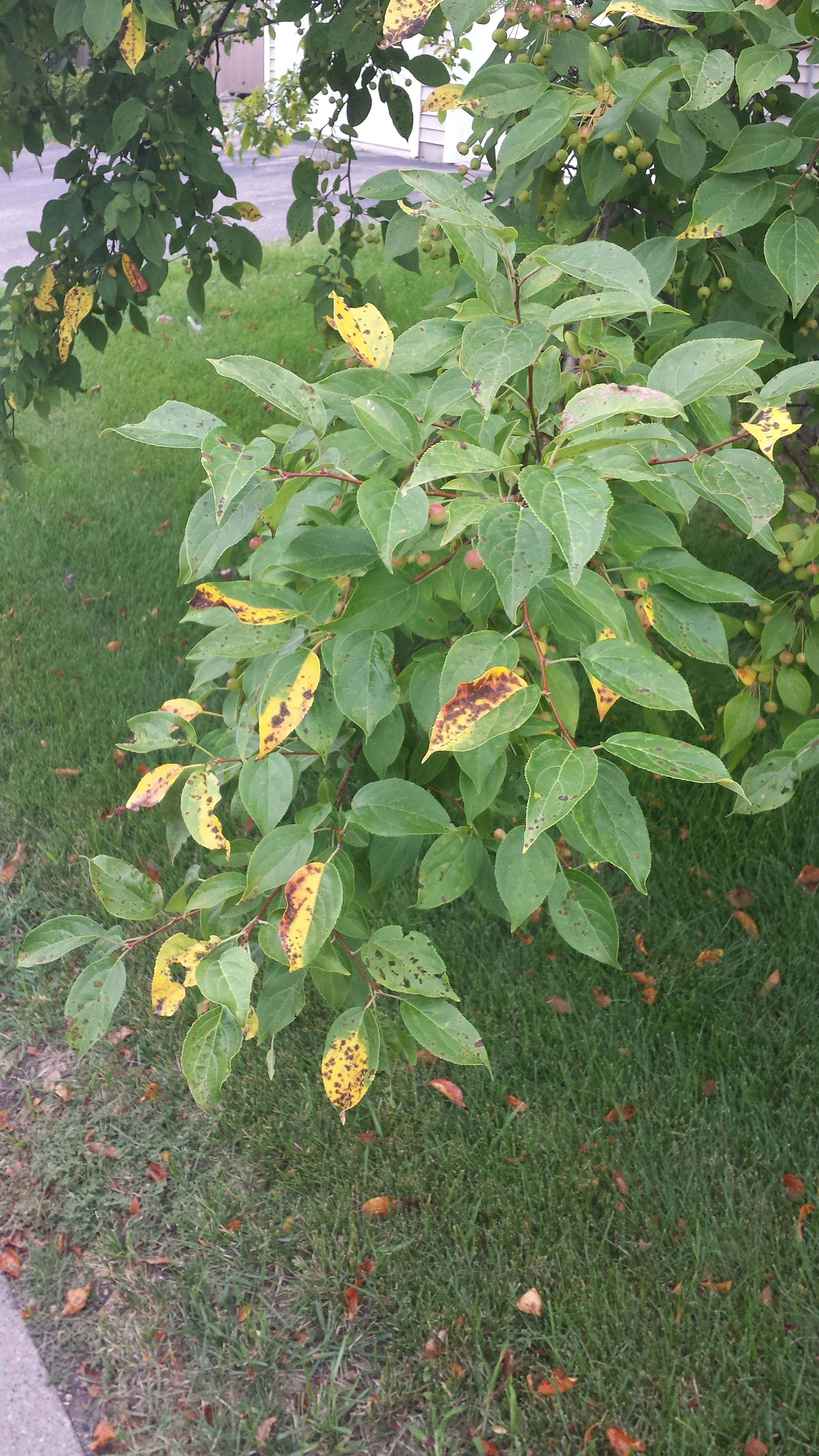TREE DISEASE Spotlight for April; Apple Scab
Apple scab is a common disease of crabapple and apple trees in Minnesota landscapes causing early leaf drop in late spring to early summer. Infected leaves will have olive green / brown lesions and will eventually turn yellow before falling off. Spring weather patterns and the variety of crabapple tree has the most impact on the severity of the disease. A spring with warmer, drier weather will result in a reduced impact from apple scab (just for that season). However, a cool and wet spring will generate a high level of apple scab issues.
Severity Level = Medium (primarily a leaf disease / not a tree killer)
The Real Issue = The fungus can cause leaf drop early in the season leaving trees looking thin and sparse before summer. Beyond the reduced aesthetics, having apple scab for several years in a row is the real concern because it can turn into a health issue. Losing leaves early for multiple years can be a very stressful situation for crabapple trees. Having a reduced number of leaves, the amount of photosynthesis and food production a tree can do will be reduced greatly. With defoliation year after year, energy reserves get depleted, and the health of the tree will decline.
Top 5 Facts
Apple Scab is caused by a fungus (Venturia inaequalis) that infects both the leaves and fruit.
Cooler, wet weather in spring generally equates to a worse season of apple scab.
Most apple scab will be prevalent on older varieties of crabapple trees because most new varieties have resistance to the disease.
Planting disease-resistant varieties is the best way to reduce the need to spray for apple scab year after year.
Fungicide applications are an effective way to manage apple scab. However, proper timing of sprays is needed for fungicides to control disease so sprays must be done preventively.
Apple Scab in June in Minnesota.
Pictures shows typical appearance of apple sab with brown lesions and yellowing leaves.
Fungicide Applications for Apple Scab
There are quite a few fungicides that will give good control of apple scab in Minnesota. Typically, a tank mix of a contact fungicide, a systemic fungicide and a spreader sticker will give the best results. A contact fungicide will act as a preventively as a “protectant”, but only gives short-term control. A systemic fungicide will give a longer range of control. If the leaves are already infected with apple scab, the systemic fungicide can help IF it has “curative” properties. Not all systemic fungicides will provide curative function so check the label. I typically prefer to use systemic fungicides that provide both curative and systemic control like myclobutanil (just to be safe).
The BIG Oak recommends rotating fungicides every year to avoid resistance to the disease. Do not spray the same fungicides year after year. This is how fungicides become less effective over time.
Picture showing early leaf drop and scattered yellow leaves throughout a crabapple tree (and lawn) in early June in Minnesota.
Additional Recommendations
Outside of planting disease-resistant crabapple varieties, there are cultural practices that can help reduce the impact of apple scab on a yearly basis. We obviously cannot impact April weather patterns, but we can rake up infected leaves each fall, provide proper mulching and make sure crabapple trees receive adequate watering. Deep root recovery fertilization can also help restore energy reserves for stressed tree. Do not fertilize with a high amount of nitrogen because we do not want growth (we want recovery). Also, provide proper pruning to include crown thinning to open up air flow in the middle of crabapple trees. This can help leaves dry quicker reducing conditions that easily spread apple scab.
Install Disease-resistant Crabapple Varieties
In recent years, most crabapple varieties are now considered apple scab resistant. However, I must comment that during an extremely cool and wet April, “resistant” crabapple types can show “some” apple scab. Here are a few of the tougher more resistant varieties in Minnesota:
Adirondack (15 feet high, 12 feet wide, white flowers with pink edge, red fruits)
Candymint (10 feet high, 15 feet wide, pink flowers, red fruit)
Harvest Gold (20 feet high, 15 feet wide, white flowers, gold fruit)
Perfect Purple (15 feet high, 15 feet wide, pink flowers, red fruit)
Royal Raindrops (20 feet high, 15 feet wide, pink flowers, red fruit, purple leaves) *
*A favorite of The BIG Oak
Royal Raindrops Crabapple
A crabapple variety offering purplish leaves all years plus excellent apple scab resistance.



